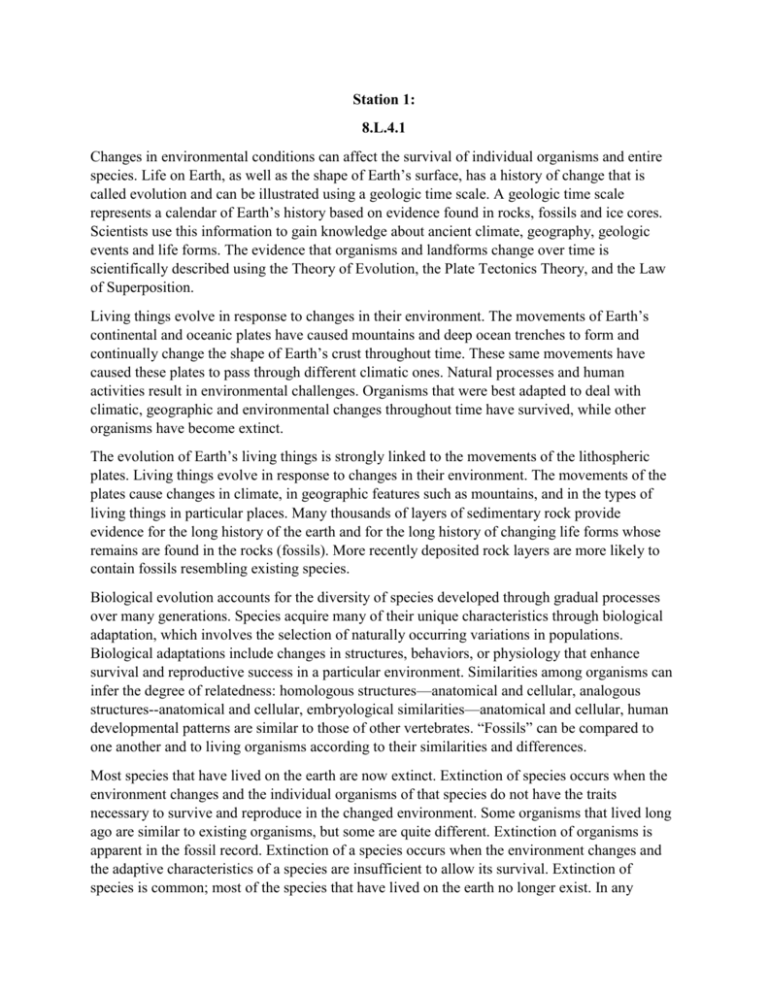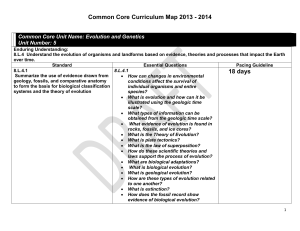3.20 stations
advertisement

Station 1: 8.L.4.1 Changes in environmental conditions can affect the survival of individual organisms and entire species. Life on Earth, as well as the shape of Earth’s surface, has a history of change that is called evolution and can be illustrated using a geologic time scale. A geologic time scale represents a calendar of Earth’s history based on evidence found in rocks, fossils and ice cores. Scientists use this information to gain knowledge about ancient climate, geography, geologic events and life forms. The evidence that organisms and landforms change over time is scientifically described using the Theory of Evolution, the Plate Tectonics Theory, and the Law of Superposition. Living things evolve in response to changes in their environment. The movements of Earth’s continental and oceanic plates have caused mountains and deep ocean trenches to form and continually change the shape of Earth’s crust throughout time. These same movements have caused these plates to pass through different climatic ones. Natural processes and human activities result in environmental challenges. Organisms that were best adapted to deal with climatic, geographic and environmental changes throughout time have survived, while other organisms have become extinct. The evolution of Earth’s living things is strongly linked to the movements of the lithospheric plates. Living things evolve in response to changes in their environment. The movements of the plates cause changes in climate, in geographic features such as mountains, and in the types of living things in particular places. Many thousands of layers of sedimentary rock provide evidence for the long history of the earth and for the long history of changing life forms whose remains are found in the rocks (fossils). More recently deposited rock layers are more likely to contain fossils resembling existing species. Biological evolution accounts for the diversity of species developed through gradual processes over many generations. Species acquire many of their unique characteristics through biological adaptation, which involves the selection of naturally occurring variations in populations. Biological adaptations include changes in structures, behaviors, or physiology that enhance survival and reproductive success in a particular environment. Similarities among organisms can infer the degree of relatedness: homologous structures—anatomical and cellular, analogous structures--anatomical and cellular, embryological similarities—anatomical and cellular, human developmental patterns are similar to those of other vertebrates. “Fossils” can be compared to one another and to living organisms according to their similarities and differences. Most species that have lived on the earth are now extinct. Extinction of species occurs when the environment changes and the individual organisms of that species do not have the traits necessary to survive and reproduce in the changed environment. Some organisms that lived long ago are similar to existing organisms, but some are quite different. Extinction of organisms is apparent in the fossil record. Extinction of a species occurs when the environment changes and the adaptive characteristics of a species are insufficient to allow its survival. Extinction of species is common; most of the species that have lived on the earth no longer exist. In any particular environment, the growth and survival of organisms depend on physical conditions. Biological classification is a system which is used to organize and codify all life on Earth. Station 2: 8.L.4.2 Individual organisms with certain traits are more likely than others to survive and have offspring. Changes in environmental conditions can affect the survival of individual organisms and entire species. Individual organisms with certain traits are more likely than others to survive and produce offspring. There is tremendous genetic diversity within almost all species, including humans. No two individuals have the same DNA sequence, with the exception of identical twins or clones. This genetic variation contributes to phenotypic variation—that is, diversity in the outward appearance and behavior of individuals of the same species. Living organisms have morphological, biochemical, and behavioral features that make them well adapted for life in the environments in which they are usually found. For example, consider the hollow bones and feathers of birds that enable them to fly, or the cryptic coloration that allow many organisms to hide from their predators. These features may give the superficial appearance that organism were designed to live in a particular environment. Evolutionary biology has demonstrated that adaptations arise through selection acting on genetic variation. Station 3: 8.L.1.1 Microbiology as a basic science explores microscopic organisms including viruses, bacteria, protozoa, parasites, and some fungi and algae. These organisms lack tissue differentiation, are unicellular, and exhibit diversity of form and size. Viruses, bacteria, fungi and parasites may infect the human body and interfere with normal body functions. A person can catch a cold many times because there are many varieties of cold viruses that cause similar symptoms. Viruses are not considered to be alive but they affect living things. Viruses need a host cell. AIDS, influenza, the common cold, polio, chicken pox, small pox, yellow fever, viral meningitis, West Nile and Ebola are caused by viruses. Rabies, Lyme Disease, bacterial meningitis, and Leprosy are caused by bacteria. Bacteria are very small organisms, usually consisting of one cell, that lack chlorophyll. Except for viruses, they are the smallest living things on Earth. Bacteria are found everywhere, in the air, soil, water, and inside of your body and on your skin. They tend to multiply very rapidly under favorable conditions, forming colonies of millions or even billions of organisms within a space as small as a drop of water. Bacteria are generally classified into three groups based on their shape: spherical, rodlike, spiral or corkscrew. We have antibiotics to help with bacterial infections and vaccines to help with taking care of viruses that cause infections. Station 4: 8.L.1.2 Vectors are mechanisms (other than a person) that spread disease without getting sick itself. Rats, ticks, mosquitoes, and soil are examples of vectors. An infectious disease is one that can be passed from one generation to another. Scientists study microbial pathogens (disease causing agents), to find methods for prevention and treatment of disease. Improvements in public health depend upon state-of-the-art biomedical research to explain how microbes cause infectious diseases in both plants and animals. To analyze data, scientists use various techniques and strategies including computer modeling, cell culture, animal models, and clinical trials in humans. Safe handling and hygiene as well as various antimicrobial chemicals can be used to reduce the risk of and the treatment of these infections. Industrial microbiology involves quality control in preventing growth and contamination of products leading to food spoilage, and the production of pharmaceuticals. The health of humans and earth depends on microbes. An epidemic is an outbreak of a disease that affects a disproportionately large number of individuals within a population, community or region at the same time (example-typhoid). Pandemic is an epidemic of an infectious disease that is spreading through human populations across a large region, continent or even worldwide (examples smallpox, tuberculosis, flu of 2009) Station 5: 8.L.5.1 Food provides molecules that serve as fuel and building material for all organisms. Organisms get energy by oxidizing their food, releasing some of its energy as thermal energy. Humans go through a process called cellular respiration in order to produce energy for their cells. Cellular respiration involves sugar that is broken down to form carbon dioxide, which is respired as a gas. In this reaction, the hydrogen in sugar combines with oxygen to form water. The energy that is released is stored temporarily in another molecule called ATP (adenosine triphosphate), which delivers and transfers the energy where it is needed. The chemical equation for cellular respiration is shown below. CH2O + O2 -> CO2 + H2O + energy Plants, on the other hand, create energy through a process called photosynthesis. Plant combine carbon dioxide and water with sunlight and from this, they make sugar. This sugar is what gives plants the energy they need to grow. The chemical equation for photosynthesis is below. 6CO2 + 6H2O - C6H12O6 + 6O2 All organisms are composed of cells-a group of organelles working together. Most organisms are single cells; other organisms, including humans, are multi-cellular. Cells carry on the many functions needed to sustain life. They grow and divide (mitosis or meiosis), thereby producing more cells. This requires that they take in nutrients, which they use to provide energy for the work that cells do and to make the materials that a cell or an organism needs. Cell (Plasma) membrane is selectively permeable, controlling what enters and leaves the cell. Sugars to produce energy for the cell are broken down in a process that uses oxygen and produces carbon dioxide and water. Cells lacking internal membrane-bound structures are called prokaryotic cells. The cells of most unicellular organisms such as bacteria are prokaryotes. Cells that contain membrane-bound structures are called eukaryotic cells. Most of the multi-cellular plants and animals we know have cells containing membrane-bound structures and are therefore called eukaryotes. The membrane-bound structures within eukaryotic cells are called organelles. Each organelle has a specific function for cell survival.







